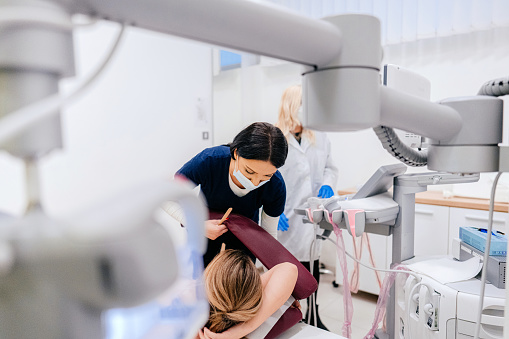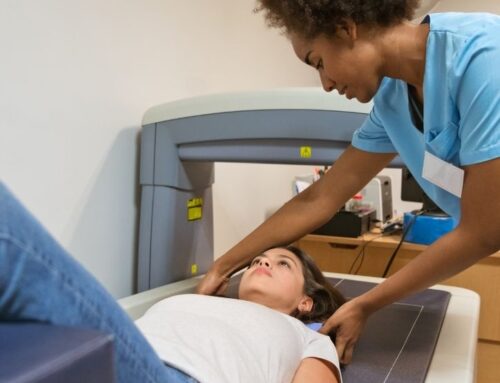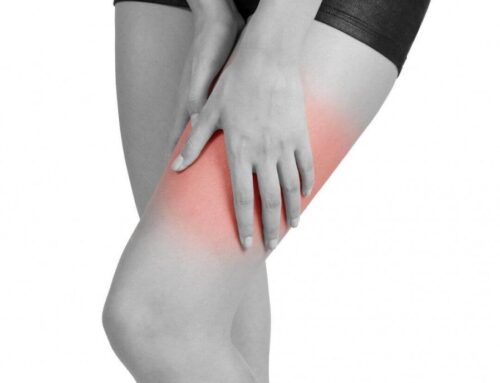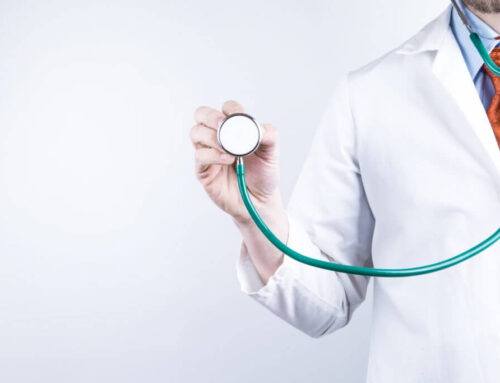Too many of us have either had or know someone who’s battled breast cancer. In healthcare, doctors are fighting back against the disease with advances in treatments, research and technology.
One of the most recent advances in technology is breast tomosynthesis, also known as 3D mammography. While 2D digital mammography is still the standard screening method for breast cancer, there are some benefits to leveling up.

Overview
A 3D mammogram (breast tomosynthesis) is an imaging test that combines multiple breast X-rays to create a three-dimensional picture of the breast.
A 3D mammogram is used to look for breast cancer in people who have no signs or symptoms. It can also be used to investigate the cause of breast problems, such as a breast mass, pain and nipple discharge.
When used for breast cancer screening, 3D mammogram machines create 3D images and standard 2D mammogram images. Studies show that combining 3D mammograms with standard mammograms reduces the need for additional imaging and slightly increases the number of cancers detected during screening. But more study is needed to understand whether 3D mammograms may reduce the risk of dying of breast cancer more than a standard mammogram alone.
The 3D mammogram is becoming more common, but it isn’t available at all medical facilities.
What’s a 3D mammogram?
3D mammography uses low-dose x-rays to take multiple cross-sectional pictures of the breast. These pictures are then “synthesized” into one image that offers a detailed look inside the breast.
Let’s look at the advantages of 3D mammograms.
Fewer call-backs
But comfort isn’t the only advantage to 3D mammography. It has been shown to improve accuracy and reduce false-positive rates for women. That means fewer call-backs and follow-up tests. Call-backs occur when the radiologist has questions about the images and women are called to come back for additional pictures.
Better for dense breast tissue
3D mammography may be a more accurate way of screening dense breasts. On a standard 2D mammogram, it’s more difficult to see underlying cancer in women with dense breasts. It’s easier when using a 3D mammography unit.
Wondering how you know if you have dense breasts? That’s a conversation all women should have with their doctors. Breasts are made up of glandular, connective and fatty tissues. They’re considered dense if they have a lot of glandular and connective tissues and not much fatty tissue. About half of women over 40 have dense breasts.
If you have dense breasts, you and your doctor might consider 3D tomosynthesis. However, most women with dense breasts and an average risk of breast cancer don’t require 3D mammograms.
When should you get screened?
The best way to prevent breast cancer is to stay on top of your screenings.that women at average risk of breast cancer start annual screening with mammograms at age 45. Women ages 40 to 44 can choose to begin getting mammograms every year if they so desire. Women can move to screening every two years starting at age 55, with an option to continue screening annually.
Not all medical facilities offer 3D mammograms. Talk to your doctor if you have questions about the best screening method for you.
Why it’s done
A 3D mammogram is used as a breast cancer screening test to look for breast cancer in people with no signs or symptoms of the disease. It can also be used to investigate breast problems, such as a suspicious lump or thickening.
When used for breast cancer screening, the 3D mammogram machine creates 3D images and standard 2D mammogram images because both types of images have some advantages in seeing certain breast abnormalities.
Combining a 3D mammogram with a standard mammogram can:
- Reduce the need for follow-up imaging. When doctors detect abnormalities on standard mammogram images, they may recommend additional imaging. Being called back for additional imaging can be stressful. It may take extra time and lead to additional costs. Combining a 3D mammogram with a standard mammogram reduces the need for follow-up imaging.
- Detect slightly more cancers than a standard mammogram alone. Studies indicate that combining a 3D mammogram with a standard mammogram can result in about one more breast cancer for every 1,000 women screened when compared with standard mammogram alone.
- Improve breast cancer detection in dense breast tissue. A 3D mammogram offers advantages in detecting breast cancer in people with dense breast tissue because the 3D image allows doctors to see beyond areas of density.
Breast tissue is composed of milk glands, milk ducts and supportive tissue (dense breast tissue) and fatty tissue. Dense breasts have greater amounts of dense breast tissue than fatty tissue. Both dense breast tissue and cancers appear white on a standard mammogram, which may make breast cancer more difficult to detect in dense breasts.
There isn’t enough evidence to conclude that 3D mammograms can reduce the risk of dying of breast cancer more than a standard mammogram alone. For this reason, most guidelines for breast cancer screening don’t specify that women should choose 3D mammograms over standard mammograms alone.
Risks
A 3D mammogram is a safe procedure. As with every test, it carries certain risks and limitations, such as:
- Exposure to a low level of radiation. A 3D mammogram uses X-rays to create an image of the breast, which exposes you to a low level of radiation. Because a 3D mammogram is usually combined with a standard mammogram, the level of radiation may be greater than a standard mammogram alone. Some newer 3D mammogram machines can create both 3D and 2D images at the same time, which lowers the amount of radiation.
- The test may find something that turns out to not be cancer. A 3D mammogram may identify an abnormality that, after additional tests, turns out to be benign or consistent with normal tissue. This is known as a false-positive result, and it can cause unneeded anxiety if you undergo additional imaging and testing, such as a biopsy, to further assess the suspicious area.
- The test can’t detect all cancers. It’s possible for a 3D mammogram to miss an area of cancer, such as if the cancer is very small or if it’s in an area that’s difficult to see.
How you prepare
To prepare for your 3D mammogram:
- Choose a facility that offers 3D mammograms. Though 3D mammograms are becoming more common, they aren’t available everywhere. If you’re interested in this test, ask your doctor whether it’s available in your area.
- Check with your insurance provider. Not all insurance companies cover 3D mammograms. Check with your insurance provider before your test so that you’ll know what types of costs to expect. Your insurance company may cover the standard mammogram portion of the test, while you’ll be responsible for the cost of the 3D mammogram portion.
- Schedule the test for a time when your breasts are least likely to be tender. If you haven’t gone through menopause, that’s usually during the week after your menstrual period. Your breasts are most likely to be tender the week before and the week during your period.
- Bring your prior mammogram images. If you’re going to a new facility for your 3D mammogram, gather any prior mammograms and bring them with you to your appointment so that the radiologist can compare them to your new images.
- Don’t use deodorant before your mammogram. Avoid using deodorants, antiperspirants, powders, lotions, creams or perfumes under your arms or on your breasts. Metallic particles in powders and deodorants can interfere with the imaging.
What you can expect
At the testing facility, you’re given a gown and asked to remove any necklaces and clothing from the waist up. To make this easier, wear a two-piece outfit that day.
For the procedure itself, you stand in front of an X-ray machine equipped to perform 3D mammograms. The technician places one of your breasts on a platform and raises or lowers the platform to match your height. The technician helps you position your head, arms and torso to allow an unobstructed view of your breast.
Your breast is gradually pressed against the platform by a clear plastic plate. Pressure is applied for a few seconds to spread out the breast tissue. The pressure isn’t harmful, but you may find it uncomfortable or even painful. If you have too much discomfort, tell the technician.
Next, the 3D mammogram machine will move above you from one side to the other as it collects images. You may be asked to stand still and hold your breath for a few seconds to minimize movement.
The pressure on your breast is released, and the machine is repositioned to take an image of your breast from the side. Your breast is positioned against the platform again, and the clear plastic plate is used to apply pressure. The camera takes images again. The process is then repeated on the other breast.
Results
The images collected during a 3D mammogram are synthesized by a computer to form a 3D picture of your breast. The 3D mammogram images can be analyzed as a whole or examined in small fractions for greater detail. For breast cancer screening purposes, the machine also creates standard 2D mammogram images.
A doctor who specializes in interpreting imaging tests (radiologist) examines the images to look for abnormalities that may be breast cancer. If the radiologist sees anything unusual, he or she will use your standard mammogram and any older mammogram images that are available to determine whether additional testing is needed.
Additional tests for breast cancer may include an ultrasound, an MRI or, sometimes, a biopsy to remove suspicious cells for testing in a lab by doctors who specialize in analyzing body tissue (pathology testing).





